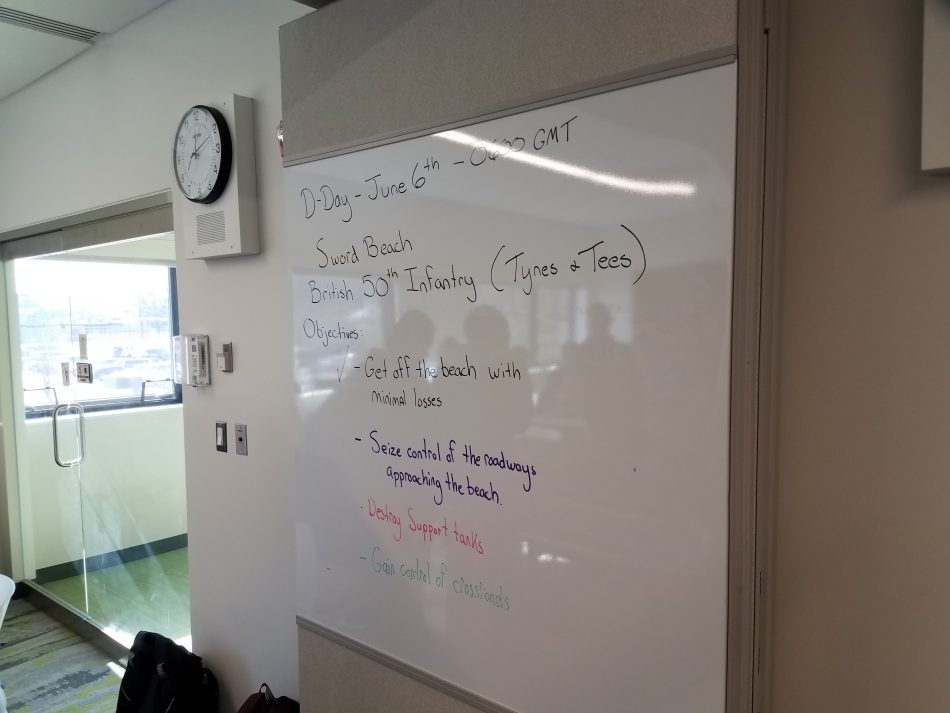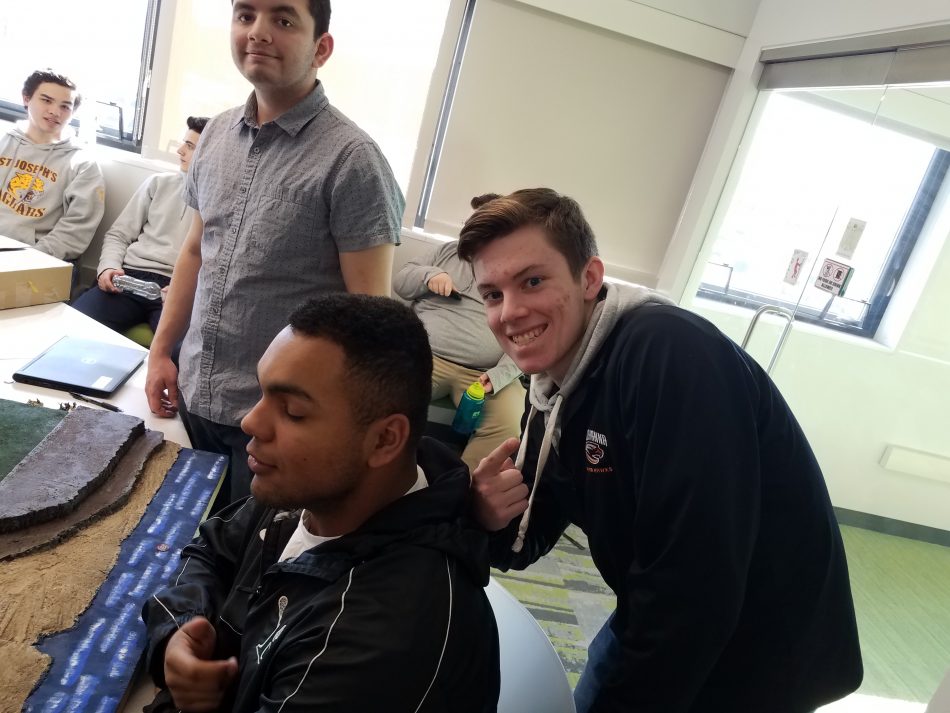D-Day in Military History class
At the high school where I teach, they offer a number of electives. About seven years ago, they solicited ideas for things they thought students would enjoy working on and learning about, and I offered up a proposal for military history. While it has changed in scope and shape over the years it has remained a popular class. This year we had a wait list to get in.
students help setupI’ve incorporated wargaming into the class on occasion and held some small-scale demonstrations for students after school, but I had not held a large scale battle for them yet. That changed this year. I also had many moments where I realized that the fact I could set this all up using only my minis was proof I don’t need more models to paint. I probably need an intervention. Still, it was nice to be able to do this.
The generals assembleStudents were allowed to vote for which of 3 possible operations or campaigns they wished to see played out.
- Operation Market Garden
- Operation Overlord
- The Battle of the Bulge
When the votes were tallied, it was D-Day by a nose. And so, over 2 days my 60 students in two sections assembled the beaches, learned the most basic interpretation of the rules I could muster and rolled a ton of dice trying to destroy each other.
two of these students don’t even take my class, they just showed up.Managing 30 students in a room is a challenge at the best of times, and even with 3 separate tables set up (2 airborne and 1 large 10-foot beach) I still had some students sitting on the sidelines for portions of the period. I rotated in as many as I could, and there was plenty of screaming and shouting at the results of the battles.
I tried to lay the groundwork for this over several months. I used the (quite helpful for the rookie player). I stayed after school on several Fridays beginning in October to let kids play the game. And by the time this activity rolled around several of my students, roughly 10 in all, knew the game well enough to run it themselves and teach others while we played.
Students teaching studentsI took over a full function room in the library for 2 days. On the back 4×4 tables I built a small crossroads and village out of the terrain I had made or collected. and in the front, I used boards built and painted by my good friend Rod for our club’s D-Day scenario. Maps and Objectives for each game were posted around the room. Students capable of teaching others worked on the smaller boards to the back. I took charge of the big monster in the front with 4 students landing on the British beach and 4 students defending Hitler’s Atlantic wall.
Operational Maps and info scattered about the room two airborne boards – one where they attacked, and one they defended
The Day went well for the airborne, on both Monday and Tuesday the allies wracked up a 3-1 record on the backboards, with the final loss being a narrow one.
airborne holding the town A Tiger stalks its preyThese Airborne games on small tables were largely run by 1 student acting as a referee, and 4 students taking command of individual platoons. Fierce fighting in the woods was ended with a failed cross check and a hail of gammon bombs
Airborne assault into the woods The airborne triumphantOn the beach, things were more of a mixed bag. German armor made it to the beach and took out all of the Achilles that managed to land. Engineering equipment made it ashore though and pulverized fortifications. Crocodile tanks made short work of those near the draws off the beach.
a confused and costly landing StuGs advanceThe German commanders were shrewd and careful with their resources, enacting an orderly withdrawal to stronger positions, and leaving a handful of strong points to delay the allies. Their strategy worked, as, by the end of the second day of fighting, the allies had not moved inland. They had success in moving off the beach and gaining control of one crossroad.
German commanders
As a teacher, I have a habit of looking back on any of these kinds of major projects and reflecting on what went well and what didn’t. With a high level of participation, and a lot of students helping others I was very satisfied with the overall results. Their final evaluation was to either;
A. write an after action report from their perspective on the battle
B. write a newspaper article recounting the day’s events.
Students were shown some stories from actual veterans and examples of AAR’s as models. We also spent time leading up to this reading excerpts from Stephen Ambrose’s Citizen Soldiers and D-Day. The writing assignments are due in a few days…and I expect at least a few will be late. (they’re mostly seniors after all)
Thanks for reading!
Tom Mullane is an editor and writer for NDNG and has been playing FOW since 2011. He lives in Danbury, CT USA and plays with Ordo-Ineptus at Hobbytown in New Milford CT.

Terrific.
This is the coolest thing ever!
Thanks guys! I’m working on a big battle of the bulge scenario for next year.
Do you use a certain curriculum?
I made my own over a period of time, if you want my syllabus or any materials, I’ll happily send them along for free. Drop me a line – TMullane@superteacher.us
Outstanding!
Outstanding educational experience. And you get to play war games at work! How cool.
Very cool!
very cool! now to start the afterschool tabletop gaming club!